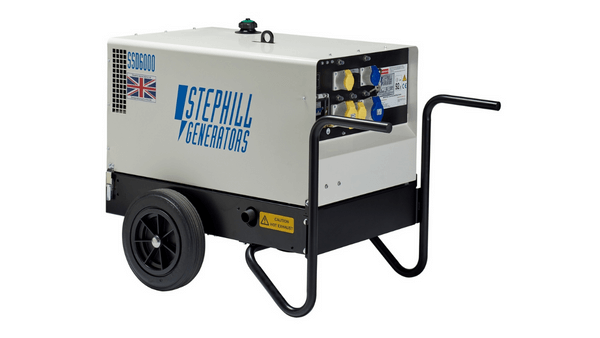How To Calculate The Size Of Generator You Need. Common Mistakes!
One of the most common issues we come across in the plant and tool hire industry is with generators. More often enough, clients underestimate their power requirements resulting in issues throughout their hire period. To avoid any of the common mistakes that come with hiring a generator for your project, we have put together this resource to help you calculate the size of generator you need.
Providing a suitable power source for your task could be the make or break of your project. Therefore, taking your time to calculate the size of the generator you need is essential to avoid any unnecessary hiccups.
Why proper sizing matters
Generators can be used for several different applications. They are the ideal solution to supply power in the most remote of situations. Hence why they are so popular for work outdoors, supplying power to events, or even offering a back up supply in emergencies. Generators offer a portable way of generating electricity.
“So, just to be sure…grab the biggest generator you can so that it covers all the power you will ever need?”
This is one of the biggest misconceptions. Generators that offer too much power in fact cause:
- Damage to electrical systems
- Inefficient power production
- Additional operation expense
However, on the opposite side, generators that have too little power may cause:
- Damage or overheating
- Insufficient power
- Breakdowns
- Potential repair costs
As you can see, there are cons on both sides of the coin, emphasising how important it is to understand how much power you need for your project.
Types of generators you can hire.
Before diving deep into the maths and equations of how to calculate what generator you need, it is beneficial to understand the different types of generators to hire on the market. This will help you identify what features may be best suitable for your project. Let’s start with the smallest of options.
Portable generators
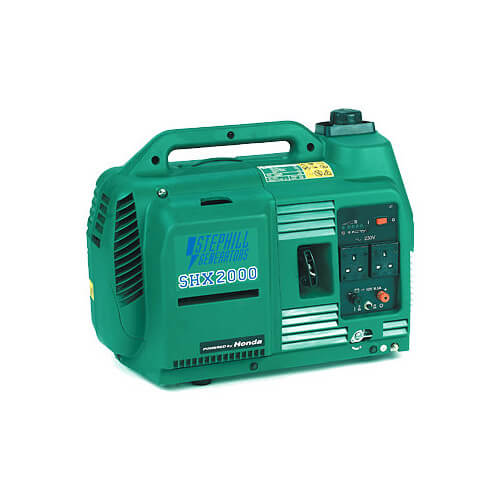
Portable generators are a lightweight option to supply power to a small area. With outputs of 850w and over 5.2KW, there is plenty to choose from depending on your requirements. Unlike large units, these are much easier to store and ideal for tool power supply.
Portable machines like this generally offer two types of outputs: 110V and 240V. Depending on your appliance’s specifications, a step-down transformer can be attached to this device to operate low-powered machinery without causing damage to the generator.
Benefits
- Portable
- Lightweight
- Safe and easy to use
- Multiple power outputs
Downfalls
- Not all portable generators are capable of powering multiple machines at the same time
- Limited amount of power
- Limited outputs available
Diesel Super Silent
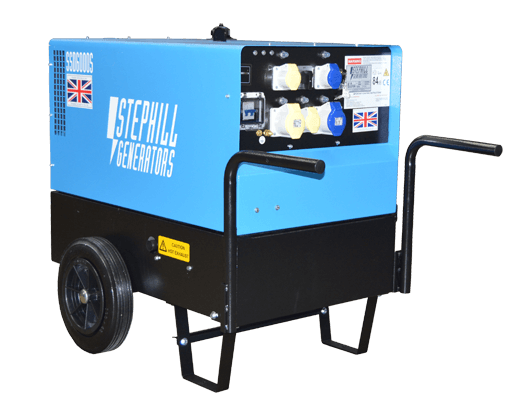
Super silent diesel generators offer a slightly less portable approach with some extra benefits. AVR protection accommodates dips in voltage current, providing far smoother operation than a portable device. Large diesel super silent generator can provide output of 2x 16amp sockets @115V/ 1 X 32amp socket @115V, 1 x 16amp @ 230v / 1 x 32amp @ 230v.
Super silent machines like this are useful for powering outdoor events or multiple pieces of equipment all at the same time. Unlike portable generators, these machines can weigh in excess of 200kg.
Benefits
- Larger power output
- Can be used during the night for work (low noise levels)
- Long run time
- 32amp output @ 110/230v
Downfalls
- Heavy and not as easy to transport as portable units.
- Much larger so requires more space to store when operational.
Diesel super silent generators offer a far more comprehensive choice of portable power. Ranging from 6KVA-10KVA, these machines are the ideal choice for most applications.
Assessing Your Output Options
If you are hiring a generator for the very first time, then understanding what outputs you require is essential to choosing the correct generator for you. You should already have a plan of what you need to run off the generator beforehand.
As we have previously discovered, not all generators have the same output sockets. Let’s have a closer look at the sockets available on each machine to familiarise ourselves with them.
16 AMP 110V
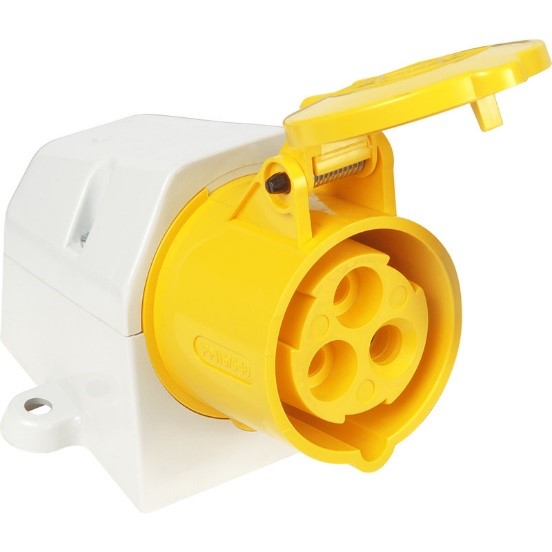
16AMP 110V sockets on a generator will appear in yellow with a three-pin fitting. Depending on the size of the generator will determine how many of these sockets are available to use. It is very common to only find one of these sockets on a portable hired generator.
16 AMP 230V

Similar to the 110V sockets, the 230V 16 AMP socket outlet is shaped the same but will be identified by its blue cover. The blue indicator identifies the 230 voltage.
32 AMP 110V
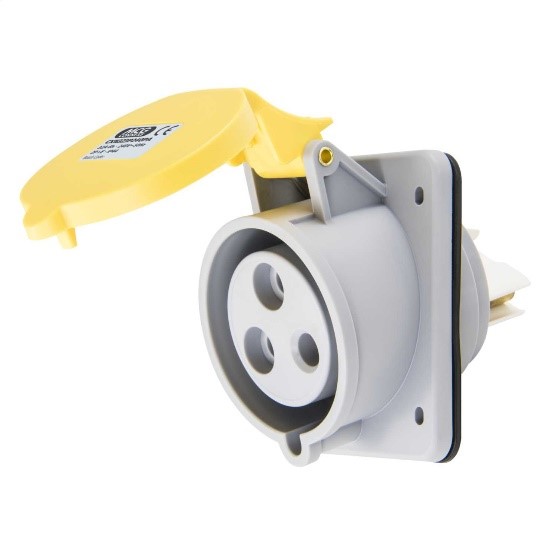
Just like its small counterpart, the 32 AMP 110V socket is indicated on a generator in yellow. However, unlike its smaller counterpart, the 32 AMP 110V socket is considerably larger. Clear indications on the outlet covers will reveal the correct amperage.
32 AMP 230V
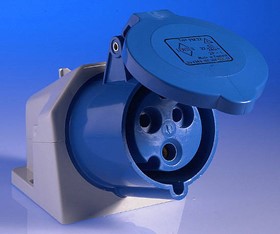
32 AMP 230V sockets are identified on a generator similar to the 16 AMP sockets, with a blue safety cover. The 32AMP sockets can be clearly identified by their markings on the socket cap. These sockets are more commonly found on larger super silent diesel generators.
Now we have distinguished the different types of sockets available, let’s look how to correctly calculate the size of the generator you need.
Calculate the size of generator you need
To prevent any nasty accidents, equipment damage, or overspending on fuel, calculating the size of the generator your need is essential. This all starts with what it is you need to power. This could be power tools, a PA system, or lighting for an outdoor event.
It is essential that you discover the voltage and the amperage of each individual item that requires power from the generator. This information can be found on the rating plate or within the manufactures operating manual of the equipment. If you cannot find the specification of the equipment, then it is worth investigating online to find a user’s manual.
Once you have determined both the voltage and amperage, we can now determine the output wattage by applying the following formula:
Amperage x Voltage = Watts
For example: –
A 110-volt heavy-duty breaker is stated as being 8 amps, therefore: –
8 Amps x 110 volts = 880 Watts
A 240-volt heavy-duty breaker is stated as being 10 amps, therefore: –
10 Amps x 240 volts = 2400 Watts
Once you understand the number of watts you need, you can then identify the size of generator you require to operate your equipment. If you get stuck, you should always get advice from a trained hire professional to ensure your safety while in use.
Socket Output Information
In general, generators will house 16 amp 110 and 240-volt sockets and will only be able to use a maximum of one piece of equipment at a time.
In some instances, some generators that house a 32-amp socket, will allow operators to use a splitting adapter cable. However it is crucial that you must not exceed a total of 20 amps overall. This could cause a potential hazard or breakdown during use.
Where can you get help calculating the size generator you need?
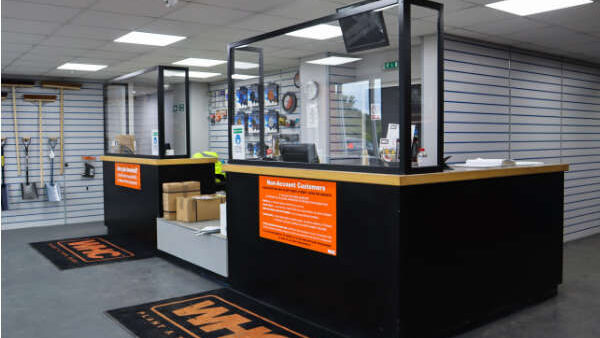
WHC Hire Services, supplies generators of all sizes for the most remote of applications across the UK. With 20 years experience of in supplying the highest and most economical plant and tool hire equipment on the market, our team can help you find the right solution to your requirements. With a vast range of portable and super silent generators fitted with 110/230v 16AMP and 32AMP outputs, our range of Stephill generators are suitable for most temporary commercial applications. Click the link below to discover more or call one of our friendly team to discuss your power requirements.

